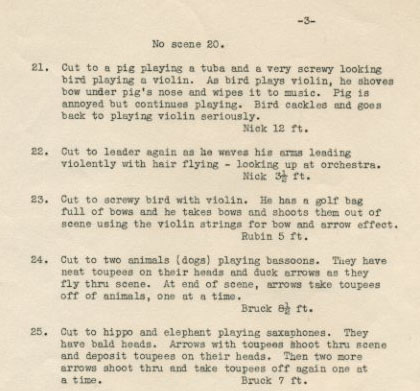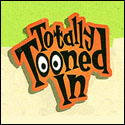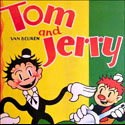
Today I am re-posting an original animators draft for the Max Fleischer “Color Classic” cartoon A Car-Tune Portrait (released June 26th, 1937). Drafts for non-Disney cartoons are scarce, but vital to identifying and studying individual animators style.
First, let’s take a look at the cartoon itself. Animators on this film include Dave Tendlar, Eli Brucker, Nick Tafuri, Joe Oriolo, Bill Sturm, and Herman Cohen. The voice of the Lion conductor (orchestra leader) was provided by radio announcer David Ross.
Now let’s go through the film, shot by shot, from this original document found in Dave Tendlar’s personal files. Note the original title was “Animal Orchestra”. The draft does not include the opening sequence of the characters being drawn by an artists hand. The film must have run short and they added this sequence late in production.


Scene 3

Scene 8
Scene 10

Scene 11
Scene 13

Scene 21

Scene 25

Scene 28

Scene 29

Scene 32


(This post was originally published, in somewhat different form, by Jerry Beck on Cartoon Research in 2006).


 Jerry Beck is a writer, animation producer, college professor and author of more than 15 books on animation history. He is a former studio exec with Nickelodeon Movies and Disney, and has written for The Hollywood Reporter and Variety. He has curated cartoons for DVD and Blu-ray compilations and has lent his expertise to dozens of bonus documentaries and audio commentaries on such. Beck is currently on the faculty of CalArts in Valencia, UCLA in Westwood and Woodbury University in Burbank – teaching animation history. More about Jerry Beck [
Jerry Beck is a writer, animation producer, college professor and author of more than 15 books on animation history. He is a former studio exec with Nickelodeon Movies and Disney, and has written for The Hollywood Reporter and Variety. He has curated cartoons for DVD and Blu-ray compilations and has lent his expertise to dozens of bonus documentaries and audio commentaries on such. Beck is currently on the faculty of CalArts in Valencia, UCLA in Westwood and Woodbury University in Burbank – teaching animation history. More about Jerry Beck [








Sort of a throwback cartoon, even at that point. Not particularly satisfying on any level.
I disagree. I thought this was one of the better cartoons of this series. It was better than the Famous Studios remake.
The cartoon’s obviously based off of Disney’s “The Band Concert”, but earns a little place in cartoon history as being the first to use Franz Lizst’s Hungarian Rhapsody as the jumping off point for the musical gags. Friz Freleng and Hanna-Barbera’s efforts are far better known, but the Fleischers got there first.
Maybe that’s the problem. It’s imitative of Disney, without enough ‘Fleischer’ to it. It hurts to think they thought they had to be more like Disney, rather than keep going radically in their own direction and distinguish themselves.
I hardly see much of “The Band Concert” in it. I mean where’s the tornado? Besides, there still some Fleischer stuff in it that I can hardly tell it’s Disney influence much.
Thematically, it’s the same — taking a piece of classical music and having the characters begin by trying to do a serious performance, and having it descend into chaos.
Disney’s writers opted to have the chaos in large part come from an external source in the tornado, while the Fleischers internalized the problem by having things fall apart entirely due to the misbehavior of various band members (which in it’s own way, reflects the attitudes of the studios — Disney was the responsible one that by the mid-30s tended to be wary of any character not wearing a sailor’s suit act as a deliberate troublemaker, while the Fleischers even in the Color Classics enjoyed showing regular characters engaged in on-screen anarchy).
The last section of your comment regarding “attitudes of studios” seems muddled. You are saying that, outside of Donald, Disney characters were not anarchic? In your earlier comment you say ‘A Car-tune Portrait’ is ‘basically’ based off ‘The Band Concert’. Later you say ‘thematically’. There is a big difference between the two. Thematically it could be said ‘A Car-Tune Portrait’ has much in common with many cartoons as does ‘The Band Concert’ depending on which theme you observe.
Thematics aside, the fact alone that the animation of Donald Duck in THE BAND CONCERT by Dick Huemer, an ex-Fleischerite, is better drawn and acted than anything in A CAR-TUNE PORTRAIT, two full years earlier, is very revealing of the differences between the two studios. Sorry, I love the Fleischer cartoons, but it’s there.
I agree to disagree. I still say it’s better than that Famous semi-remake that I wish I remember the name of the short.
The Famous Studios remake was Philharmaniacs (1953).
Thanks, Jerry. And to be clear, I do agree Disney’s animation was better than Fleischers’ here (heck, few could top at Disney animation at this time).
‘The Band Concert’ and ‘A Car-Tune Portrait’ are two different films created by different studios with different agendas. ‘The Band Concert’ contains a sort of naturalistic animation that would come to fruition in the Disney features. By many accounts virtually all the shorts of Disney produced at the time of ‘The Band Concert’ were something of a dry-run for Snow White. Conversely there was no such deliberate intention with the Fleischer cartoons. They were primarily interested in producing polished professional short cartoons with no foresight beyond that. One could postulate this is why the two Fleischer features seem so uneven compared to the shorts. In terms of design, an argument could be made for ‘The Band Concert’ being the ‘throwback’. In this case: to the earlier style of films like ‘The Opry House’. The animals in ‘ A Car-tune Portrait’ are contemporary to the kinds of cartoons Tendlar was doing in 1937. While there can be no doubt to the quality of some of the animated sequences in ‘The Band Concert’ it’s quite an uneven film. The business of Donald, charming or not, has nothing to do with the rest of the cartoon and has always seemed to me added in to give some practice (that dry-run again) to an animator in depicting ‘personality’ animation. When the twister finally shows up all the amazing animation taking place perhaps obscures that it’s appearance, presumably brought about by Mickey’s selection of ‘The Storm’ (?), seems tacked on to give the cartoon an ending. So, the final denouement does not result from from ‘The Band Concert’, or even Donald’s personality, but a random act of nature.
If “The Band Concert” is *about* anything, it’s about Mickey’s dogged determination. Trolling Donald and his flutes, horn clams, a bee, an errant scoop of ice cream, the tornado – nothing stops him from seeing his ragtag little concert through. You know he triumphs in that glorious moment of the climax where he gestures a pause, and the music and the storm come to a halt – Mickey is conducting both. You could probably read an “Artist vs. The World” interpretation into that, and Disney (striving self-made man that he was) may even have had such a notion in the back of his head. Fortunately the film doesn’t take Mickey as seriously as he takes himself, and that’s one reason why it’s so funny.
You won’t find such resonances in the Fleischer cartoons, but at their best – grungy and lowlife with freewheeling gags – they aren’t needed or even desirable. The whole “Color Classics” series was their attempt to compete on Walt’s turf, with predictably spotty results. They did much better with the Popeye two-reelers in Technicolor. I wonder how Fleischer Studios would have made out had they produced a Popeye feature instead of “Gulliver’s Travels”.
In defense of this cartoon….. I remember seeing this on TV as a child growing up in Boston. I had two aunts who were
classical musicians so I learned about classical music at an early age and recognized the piece as soon as I heard it. I
find that it is quite creative in it’s use of imagery for the alternate use of musical instruments such as the machine gun
pea-shooter flute and the bird becoming a set of bagpipes As to the bird, an unbridled and zany fellow, I detect a bit of
Harpo Marx influence. Interesting in that he wasn’t playing a harp or maybe they felt that it would have been too much
of a give-away?
Also worth mentioning is the style of animation used at the beginning where the hands that draw and remove the pictures
of the orchestra members are not actually animated themselves, with dexterity and movement, but just move about the
screen painting the images. It reminds me of the style of animated hands I have seen in some of Terry Gilliam’s (Monty
Python) work. As he is an American by birth I wonder if this cartoon may have influenced him?
why don”t you make a Baxter’s breakdown for this
Good idea! Maybe next week.